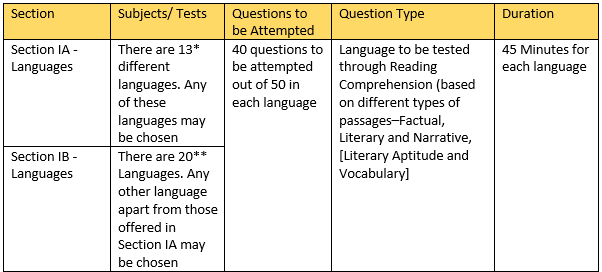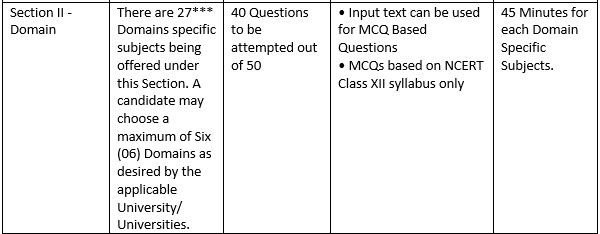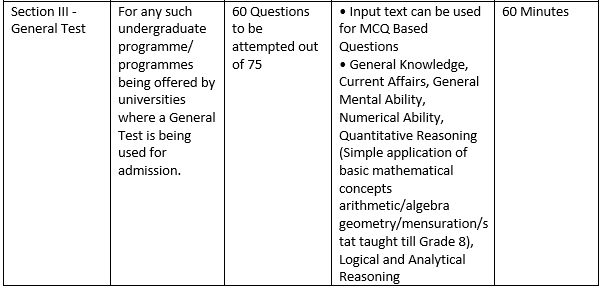What is CUET (UG)?
Common University Entrance Test CUET (UG), is a national level exam for admission to different undergraduate programmes of the Central Universities. It will provide a single window opportunity to students seeking admission in any of the Central Universities (CUs) across the country. Exam will be conducted in 13 languages. It will ensure that students from rural backgrounds, coming from different economic backgrounds and are geographically distributed across the country, be treated at par. CUET may be conducted twice a year from next session.
National Testing Agency (NTA) has been entrusted with the responsibility of conducting the Undergraduate entrance tests for all the Central Universities (CUs) for the academic session 2022-2023. NTA is established by Ministry of Education, MoE (Earlier known as Ministry of Human Resource Development-MHRD) as an independent/ autonomous, self-reliant and self-sustained premier testing organization.
Contact details
- Helpline Number: +91-11-40759000/69227700
- e-mail: cuet-ug@nta.ac.in
- Website (for information): www.nta.ac.in
- Website (for registration and results): https://cuet.samarth.ac.in/
List of participating Universities
Read the instruction twice before you start the registration procedure. For registration - CUET Registration
Which are the universities accepting CUET scores for admission?
Renowned universities like JNU (Jawaharlal Nehru University), DU (University of Delhi), Jamia Millia Islamia will accept admission based on CUET scores.
As per UGC chairman, all central universities will have to admit students to undergraduate courses based on the Common University Entrance Test (CUET) and not on Class 12 marks. The new rule will come into force from the upcoming academic year (2022-23).
Eight deemed-to-be universities including the Tata Institute of Social Sciences (TISS) and Jamia Hamdard have also expressed a desire to use Common University Entrance Test (CUET) scores to admit students to undergraduate course.
Moreover, all universities across India can use Central University Entrance Test scores for admissions. Most likely, many private and state universities will also start accepting CUET scores much like JEE and NEET scores are accepted by most of the engineering and all medical colleges respectively.
What programmes are offered in these Universities?
Each university offers programmes separately. The details of the programmes offered by Central Universities (CUs) are being made available on their respective websites.
The aspirants may refer to the Information Bulletin for admission to Undergraduate programmes of the desired Central Universities (CUs) for admission into the Undergraduate Programmes.
Why do we need CUET when we already have a system in place?
The current system does not provide equal opportunity to all students across the boards. Every board has a certain way of evaluation and marking scheme. Some boards are designed in such a way that students score very high and thus leading to insane cut-off (100% cut-off in many institute) for admission, which is unrealistic and also unfair to students of other boards. CUET is going to be one exam - one evaluation system and all student will have to compete at equal level.
But, one more exam for students! Isn't it like putting more burden on students who are already stressed with board exam?
On the contrary, it will be the opposite. As board exam score will not be required for admission in university, it is going to lessen the stress. Students should now focus on learning than scoring 100%. Yes, they still need to secure minimum mark in 12th board as per the criteria of respective university.
As per UGC chairman, CUET is going to be student friendly. So, preparation will not be very stressful for the students. Domain and language knowledge will be tested as per XIIth syllabus. Students should be able to manage well if have read as per their syllabus.
Moreover, this is not new. Many universities conduct their own entrance tests. Students also write exams like JEE and NEET to take admission in professional courses. CUET is simplifying the process. Now, student need not write multiple exams for admission in central universities.
Then, why don't just obsolete the 12th board exam when there is no need of board score?
The universities will still use board exams as qualifying criteria. Some universities can peg the requirement at 60 per cent, some may choose to set 70 per cent as a requirement, so there is no question of board exams being made irrelevant. Moreover, CUET score is mandatory only in central university. Private and state boards may still require 12th score for admission cut-off.
Additionally, those students who would not be able to continue education after 12th, 12th board score card and certificate will be the proof of their qualification.
What is the Syllabus and Pattern of CUET?
Basic details
- Mode of the test: Computer Based Test-CBT
- Test Pattern: Objective type with Multiple Choice Questions
- Medium: 13 languages (Tamil, Telugu, Kannada, Malayalam, Marathi, Gujarati, Odiya, Bengali, Assamese, Punjabi, English, Hindi and Urdu)
Section summary
CUET (UG) - 2022 will consist of the following 4 Sections:
- Section IA - 13 Languages
- Section IB - 20 Languages
- Section II - 27 Domain specific Subjects
- Section III - General Test
Choosing options from each Section is not mandatory. Please visit sites of respective universities and choose your option based on their requirements.
Download the syllabus here - CUET Syllabus
Notes
1. Maximum number of tests can be taken is nine (9) from all 4 sections combined.
2. Section I will test language skill. A Candidate can choose a maximum of any 3 languages from Section IA and Section IB taken together. However, the third language chosen needs to be in lieu of 6th domain specific Subject chosen by the candidate - as applicable.
3. Section II will test domain knowledge and offers 27 Subjects, out of which a candidate may choose a maximum of 6 Subjects. All questions in various testing areas will be benchmarked at the level of Class XII only.
4. Section III comprises General Test, for any such undergraduate programme/ programmes being offered by universities where a General Test is being used for admission.
5. Flexibility being provided to help a candidate apply for many Universities depending on their eligibility conditions. Examples of option selection
- 2 Languages+6 Domain Specific Subjects+1 General Test
- 3 Languages+5 Domain Specific Subjects+1 General Test
Exam Pattern



* Languages (13): Tamil, Telugu, Kannada, Malayalam, Marathi, Gujarati, Odiya, Bengali, Assamese, Punjabi, English, Hindi and Urdu
** Languages (20): French, Spanish, German, Nepali, Persian, Italian, Arabic, Sindhi, Sanskrit, Kashmiri, Konkani, Bodo, Dogri, Maithili, Manipuri, Santhali, Tibetan, Japanese, Russian, Chinese.
*** Domain Specific Subjects (27):
- Accountancy/ Book Keeping
- Biology/ Biological Studies/ Biotechnology/Biochemistry
- Business Studies
- Chemistry
- Computer Science/ Informatics Practices
- Economics/ Business Economics
- Engineering Graphics
- Entrepreneurship
- Geography/Geology
- History
- Home Science
- Knowledge Tradition and Practices of India
- Legal Studies
- Environmental Science
- Mathematics
- Physical Education/ NCC /Yoga
- Physics
- Political Science
- Psychology
- Sociology
- Teaching Aptitude
- Agriculture
- Mass Media/ Mass Communication
- Anthropology
- Fine Arts/ Visual Arts (Sculpture/ Painting)/Commercial Arts,
- Performing Arts - (i) Dance (Kathak/ Bharatnatyam/ Oddisi/ Kathakali/Kuchipudi/ Manipuri (ii) Drama - Theatre (iii) Music General (Hindustani/ Carnatic/ Rabindra Sangeet/ Percussion/ Non-Percussion)
- Sanskrit
Sanskrit as domain subject
For all Shastri (Shastri 3 years/ 4 years Honours) Equivalent to B.A./B.A. Honours courses i.e. Shastri in Veda, Paurohitya (Karmakand), Dharamshastra, Prachin Vyakarana, Navya Vyakarana, Phalit Jyotish, Siddhant Jyotish, Vastushastra, Sahitya, Puranetihas, Prakrit Bhasha, Prachin Nyaya Vaisheshik, Sankhya Yoga, Jain Darshan, Mimansa, AdvaitaVedanta, Vishihstadvaita Vedanta, Sarva Darshan, a candidate may choose Sanskrit as the Domain.
For those who are writing Sanskrit as a domain subject in Section 2, Sanskrit paper in Section 1B will be used for testing their Reading Comprehension (based on different types of passages-Factual, Literary and Narrative, [Literary Aptitude and Vocabulary]
How to Prepare for CUET?
CUET will be, as suggested by UGC chairman, a student-friendly exam. Preparation and focus are the keys to success. Avoid junk food and junk activities (social media and OTT).
Preparation Tips
1. Domain and Language exams will be based on 12th syllabus. As MCQ, it will test only conceptual knowledge.
For better understanding of concept, read each concept at least three time from NCERT books and Exemplars. Also, refer books and online resources for each topic for in-depth study. Khan Academy (https://www.khanacademy.org/) is a wonderful and free resource site.
2. General Test includes General Knowledge, Current Affairs, General Mental Ability, Numerical Ability, Quantitative Reasoning (Simple application of basic mathematical concepts arithmetic/algebra geometry/mensuration/s tat taught till Grade 8), Logical and Analytical Reasoning.
Don't consider them just as a syllabus of one exam. They are life skills and should be practiced regularly. For every field of work/study after 12th, it will be useful.
3. Make a habit of making notes. Don't copy from books. Write your understanding in your own words.
Write any interesting learning that you came across, any new method you thought and learnt, short-cuts, formulae, just note down in your words. Revision will be quick and you will not feel stressed before the exam.
4. Mock tests are very important. First you take the mock test as per specified time limit. Re-take the test without checking the answer until you have spent sufficient time on each question without any time constraints. Now analyze your answer with given solution.
Roughly for one hour of mock test, you may spend 1hr mock test + 3 hrs time-free test + 1 hr solution analysis. This method will give immense clarity to your concept and thought process. Career Launcher and Akash BYJU offer sample mock tests.
5. In the exam, don't stuck on a question for long time. You may miss easy ones and time runs out. During mock test, try to analyze how much time you can spend on one question before moving on. Always start from the section in which you are most comfortable.
6. Healthy eating, good sleep and 30 min of daily physical activity are required for active mind. Eat protein and Vitamin rich food. Include nuts (walnut and almond) and seasonal fruits in your daily diet. Be hydrated.
Read Also: 6 ways to boost kids immune system
Books for General test
General Knowledge & Current Affairs
- Newspapers (The Hindu, Indian Express, Economic Times, Financial Express)
- Manorama Year Book.
- Tell me why book from Manorama Publications are fun learning books.
Numerical Ability & Quantitative Reasoning
- NCERT Mathematics Books for Class 7 & 8
- Objective Arithmetic by Rajesh Verma - Arihant Publication
- Quantitative Aptitude for Competitive Examinations by R.S. Aggarwal - S. Chand Publication
- The Pearson Guide to Quantitative Aptitude by Dinesh Khattar
- Quantum CAT by Sarvesh K Verma - Arihant Publication
General Mental Ability & Logical and Analytical Reasoning
- A Modern Approach to Verbal & Non-Verbal Reasoning by R.S. Aggarwal - S. Chand Publication
- Analytical Reasoning by M.K. Pandey - BSC Publication
- Data Interpretation by Arun Sharma - Mc Graw Hill
- A New Approach to Reasoning Verbal and Non-Verbal B.S. Sijwali and Indu Sijwali - Arihant
- Shortcuts in Reasoning for Competitive Exams by Disha Experts
- How to Prepare for Logical Reasoning for the CAT by Arun Sharma - Pearson
How the admissions will be given?
Admissions are handled at the level of each of these Central Universities for their respective programs. After the declaration of the CUET results, the respective Central Universities will declare the counselling/admission schedule and merit list based on the weightage on CUET 2022 score and the other criteria of participating universities. Please visit the website of the concerned university for details.
What are the timelines?
- Registration link open - 06.04.2022
- Registration date - 06.04.2022 to 06.05.2022
- Exam - First and second week of July, 2022
- Timing - Slot 1: 09.00 AM to 12.15 PM (IST) & Slot 2: 03.00 PM to 06.45 PM (IST)
- Result (Tentative) - July/Aug 2022
How can I apply for the exam?
Application form
Online Application Forms for Undergraduate Programmes will open from 02.04.2022, the link for the same will be made available on the official website https://cuet.samarth.ac.in/. Candidates who wish to appear for CUET (UG) - 2022 are advised to go through the required eligibility of the desired University/ Universities for selecting the options from UG Programmes being offered. The Application will be open from 02.04.2022 to 30.04.2022
Notes
Generally, the languages/subjects chosen should be the ones that a student has opted in his latest Class XII Board examination. However, if any University permits any flexibility in this regards, the same can be exercised under CUET (UG) - 2022 also. Candidates must carefully refer to the eligibility requirements of various Central Universities in this regard.
Moreover, if the subject to be studied in the Undergraduate course is not available in the list of 27 Domain Specific Subject being offered, the Candidate may choose the Subject closest to his/her choice for e.g. For Biochemistry the candidate may choose Biology.
For complete details about application - Application Guide
Some History
The predecessor of CUET, the Central Universities Common Entrance Test (CUCET) was launched in 2010 when seven newly established Central universities subscribed to it. In 2012, the government tried to extend this to all Central universities, but old universities expressed their concern over the impact it would have on the quality of students admitted. Over the years, more newly set-up Central universities adopted the common entrance, but the older ones stayed away. In 2021, only 12 Central universities subscribed to CUET. From academic year 2022-23, CUET is mandatory for all central university.
Participating Universities List
There are 44 participating central universities and 16 other participating universities as on 13.04.2022
List of Central Participating Universities
More details about participating university - Participating Universities
Note - Indira Gandhi National Open University (IGNOU) is not yet listed as participating university on Samarth site.
List of Other Participating Universities
For any other doubt, refer - CUET FAQ



